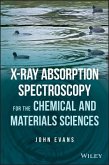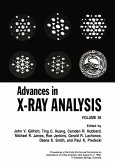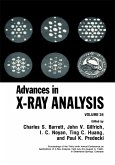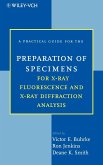- Gebundenes Buch
- Merkliste
- Auf die Merkliste
- Bewerten Bewerten
- Teilen
- Produkt teilen
- Produkterinnerung
- Produkterinnerung
"Gamma-ray spectrometry is a key technique in the study of the decay of radioactive materials. Used by scientists from a wide range of disciplines, it measures radioactivity for assay and for environmental monitoring purposes. Natural sources come from atmospheric interactions such as cosmic ray sources and artificial sources come from nuclear reactors and high energy physics experiments"--
Andere Kunden interessierten sich auch für
![Practical Gamma-Ray Spectrometry Practical Gamma-Ray Spectrometry]() Gordon GilmorePractical Gamma-Ray Spectrometry200,99 €
Gordon GilmorePractical Gamma-Ray Spectrometry200,99 €![X-Ray Absorption Spectroscopy for the Chemical and Materials Sciences X-Ray Absorption Spectroscopy for the Chemical and Materials Sciences]() John EvansX-Ray Absorption Spectroscopy for the Chemical and Materials Sciences65,99 €
John EvansX-Ray Absorption Spectroscopy for the Chemical and Materials Sciences65,99 €![Advances in X-Ray Analysis Advances in X-Ray Analysis]() Advances in X-Ray Analysis39,99 €
Advances in X-Ray Analysis39,99 €![Advances in X-Ray Analysis Advances in X-Ray Analysis]() C.S. Barrett (ed.) / M. Amara / Ting C. Huang / Nick Bernard / Dietrich KnorrAdvances in X-Ray Analysis109,99 €
C.S. Barrett (ed.) / M. Amara / Ting C. Huang / Nick Bernard / Dietrich KnorrAdvances in X-Ray Analysis109,99 €![Principles and Applications of ESR Spectroscopy Principles and Applications of ESR Spectroscopy]() Anders LundPrinciples and Applications of ESR Spectroscopy37,99 €
Anders LundPrinciples and Applications of ESR Spectroscopy37,99 €![A Practical Guide for the Preparation of Specimens for X-Ray Fluorescence and X-Ray Diffraction Analysis A Practical Guide for the Preparation of Specimens for X-Ray Fluorescence and X-Ray Diffraction Analysis]() Victor E. Buhrke / Ron Jenkins / Deane K. Smith (Hgg.)A Practical Guide for the Preparation of Specimens for X-Ray Fluorescence and X-Ray Diffraction Analysis286,99 €
Victor E. Buhrke / Ron Jenkins / Deane K. Smith (Hgg.)A Practical Guide for the Preparation of Specimens for X-Ray Fluorescence and X-Ray Diffraction Analysis286,99 €![Optical Spectroscopy of Inorganic Solids Optical Spectroscopy of Inorganic Solids]() Imbusch HendersonOptical Spectroscopy of Inorganic Solids118,99 €
Imbusch HendersonOptical Spectroscopy of Inorganic Solids118,99 €-
-
-
"Gamma-ray spectrometry is a key technique in the study of the decay of radioactive materials. Used by scientists from a wide range of disciplines, it measures radioactivity for assay and for environmental monitoring purposes. Natural sources come from atmospheric interactions such as cosmic ray sources and artificial sources come from nuclear reactors and high energy physics experiments"--
Produktdetails
- Produktdetails
- Verlag: John Wiley & Sons Inc
- Seitenzahl: 528
- Erscheinungstermin: 31. Oktober 2024
- Englisch
- ISBN-13: 9781119896081
- ISBN-10: 1119896088
- Artikelnr.: 70149107
- Verlag: John Wiley & Sons Inc
- Seitenzahl: 528
- Erscheinungstermin: 31. Oktober 2024
- Englisch
- ISBN-13: 9781119896081
- ISBN-10: 1119896088
- Artikelnr.: 70149107
Gordon Gilmore, PhD, worked at the Universities Research Reactor (owned by Manchester and Liverpool Universities and now decommissioned) using gamma spectrometry, originally as an adjunct to chemical analysis, at a time when detectors and instrumentation were being developed from their relatively primitive beginnings to their modern sophisticated forms. That 25 years of experience, along with the late John Hemingway, led to the publication of the first edition of this work, with the intention of sharing a deep understanding of gamma spectrometry with the expanding population of gamma spectrometrists within universities and many establishments where radioactivity is used or studied. After his retirement from the University, as a director of Nuclear Training Services Ltd., he was called upon to lecture, develop methods and advise on setting up gamma spectrometry facilities. He is an Honorary Professor at the University of Liverpool. David Joss, PhD, is Professor of Physics at the University of Liverpool, UK, where he teaches undergraduate and postgraduate courses in nuclear physics. His research focuses on understanding the structure of the atomic nucleus using gamma-ray spectroscopy with large spectrometer arrays. He has published over 200 research articles from his research. He is a Fellow in the Institute of Physics and a Fellow of the Higher Education Academy.
Table of Contents Preface to the Second Edition Preface to the Second
Edition Preface to the First Edition Internet Resources within the Book 1.
Radioactive Decay and the Origin of Gamma and X-Radiation 2. Interactions
of Gamma Radiation with Matter 3. Semiconductor Detectors for Gamma-Ray
Spectrometry 4. Electronics for Gamma-Ray Spectrometry 5. Statistics of
Counting 6. Resolution: Origins and Control 7. Spectrometer Calibration 8.
True Coincidence Summing 9. Computer Analysis of Gamma-Ray Spectra 10.
Scintillation Spectrometry 11. Choosing and Setting up a Detector, and
Checking its Specifications 12. Troubleshooting 13. Low Count Rate Systems
14. High Count Rate Systems 15. Ensuring Quality in Gamma-Ray Spectrometry
16. Gamma Spectrometry of Naturally Occurring Radioactive Materials (NORM)
17. Applications Appendix A: Sources of Information Appendix B: Gamma- and
X-Ray Standards for Detector Calibration Appendix C: X-Rays Routinely Found
in Gamma Spectra Appendix D: Gamma-Ray Energies in the Detector Background
and the Environment Appendix E: Chemical Names, Symbols and Relative Atomic
Masses of the Elements Glossary Index
Edition Preface to the First Edition Internet Resources within the Book 1.
Radioactive Decay and the Origin of Gamma and X-Radiation 2. Interactions
of Gamma Radiation with Matter 3. Semiconductor Detectors for Gamma-Ray
Spectrometry 4. Electronics for Gamma-Ray Spectrometry 5. Statistics of
Counting 6. Resolution: Origins and Control 7. Spectrometer Calibration 8.
True Coincidence Summing 9. Computer Analysis of Gamma-Ray Spectra 10.
Scintillation Spectrometry 11. Choosing and Setting up a Detector, and
Checking its Specifications 12. Troubleshooting 13. Low Count Rate Systems
14. High Count Rate Systems 15. Ensuring Quality in Gamma-Ray Spectrometry
16. Gamma Spectrometry of Naturally Occurring Radioactive Materials (NORM)
17. Applications Appendix A: Sources of Information Appendix B: Gamma- and
X-Ray Standards for Detector Calibration Appendix C: X-Rays Routinely Found
in Gamma Spectra Appendix D: Gamma-Ray Energies in the Detector Background
and the Environment Appendix E: Chemical Names, Symbols and Relative Atomic
Masses of the Elements Glossary Index
Table of Contents Preface to the Second Edition Preface to the Second
Edition Preface to the First Edition Internet Resources within the Book 1.
Radioactive Decay and the Origin of Gamma and X-Radiation 2. Interactions
of Gamma Radiation with Matter 3. Semiconductor Detectors for Gamma-Ray
Spectrometry 4. Electronics for Gamma-Ray Spectrometry 5. Statistics of
Counting 6. Resolution: Origins and Control 7. Spectrometer Calibration 8.
True Coincidence Summing 9. Computer Analysis of Gamma-Ray Spectra 10.
Scintillation Spectrometry 11. Choosing and Setting up a Detector, and
Checking its Specifications 12. Troubleshooting 13. Low Count Rate Systems
14. High Count Rate Systems 15. Ensuring Quality in Gamma-Ray Spectrometry
16. Gamma Spectrometry of Naturally Occurring Radioactive Materials (NORM)
17. Applications Appendix A: Sources of Information Appendix B: Gamma- and
X-Ray Standards for Detector Calibration Appendix C: X-Rays Routinely Found
in Gamma Spectra Appendix D: Gamma-Ray Energies in the Detector Background
and the Environment Appendix E: Chemical Names, Symbols and Relative Atomic
Masses of the Elements Glossary Index
Edition Preface to the First Edition Internet Resources within the Book 1.
Radioactive Decay and the Origin of Gamma and X-Radiation 2. Interactions
of Gamma Radiation with Matter 3. Semiconductor Detectors for Gamma-Ray
Spectrometry 4. Electronics for Gamma-Ray Spectrometry 5. Statistics of
Counting 6. Resolution: Origins and Control 7. Spectrometer Calibration 8.
True Coincidence Summing 9. Computer Analysis of Gamma-Ray Spectra 10.
Scintillation Spectrometry 11. Choosing and Setting up a Detector, and
Checking its Specifications 12. Troubleshooting 13. Low Count Rate Systems
14. High Count Rate Systems 15. Ensuring Quality in Gamma-Ray Spectrometry
16. Gamma Spectrometry of Naturally Occurring Radioactive Materials (NORM)
17. Applications Appendix A: Sources of Information Appendix B: Gamma- and
X-Ray Standards for Detector Calibration Appendix C: X-Rays Routinely Found
in Gamma Spectra Appendix D: Gamma-Ray Energies in the Detector Background
and the Environment Appendix E: Chemical Names, Symbols and Relative Atomic
Masses of the Elements Glossary Index







